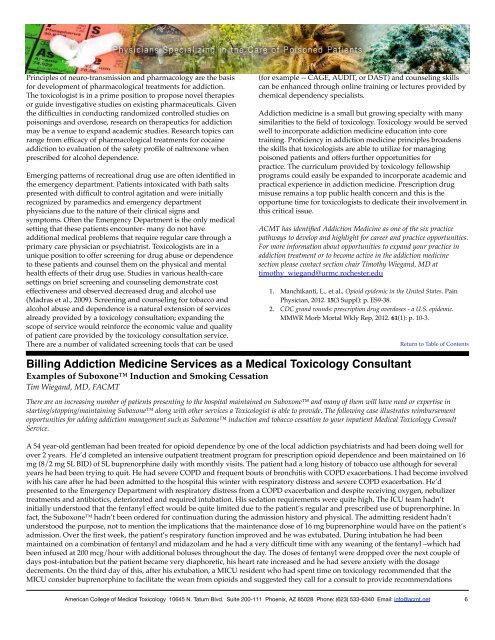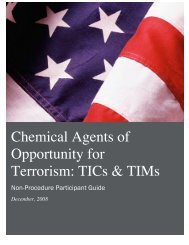March 2013 Newsletter - American College of Medical Toxicology
March 2013 Newsletter - American College of Medical Toxicology
March 2013 Newsletter - American College of Medical Toxicology
Create successful ePaper yourself
Turn your PDF publications into a flip-book with our unique Google optimized e-Paper software.
Principles <strong>of</strong> neuro-transmission and pharmacology are the basisfor development <strong>of</strong> pharmacological treatments for addiction.The toxicologist is in a prime position to propose novel therapiesor guide investigative studies on existing pharmaceuticals. Giventhe difficulties in conducting randomized controlled studies onpoisonings and overdose, research on therapeutics for addictionmay be a venue to expand academic studies. Research topics canrange from efficacy <strong>of</strong> pharmacological treatments for cocaineaddiction to evaluation <strong>of</strong> the safety pr<strong>of</strong>ile <strong>of</strong> naltrexone whenprescribed for alcohol dependence.Emerging patterns <strong>of</strong> recreational drug use are <strong>of</strong>ten identified inthe emergency department. Patients intoxicated with bath saltspresented with difficult to control agitation and were initiallyrecognized by paramedics and emergency departmentphysicians due to the nature <strong>of</strong> their clinical signs andsymptoms. Often the Emergency Department is the only medicalsetting that these patients encounter- many do not haveadditional medical problems that require regular care through aprimary care physician or psychiatrist. Toxicologists are in aunique position to <strong>of</strong>fer screening for drug abuse or dependenceto these patients and counsel them on the physical and mentalhealth effects <strong>of</strong> their drug use. Studies in various health-caresettings on brief screening and counseling demonstrate costeffectiveness and observed decreased drug and alcohol use(Madras et al., 2009). Screening and counseling for tobacco andalcohol abuse and dependence is a natural extension <strong>of</strong> servicesalready provided by a toxicology consultation; expanding thescope <strong>of</strong> service would reinforce the economic value and quality<strong>of</strong> patient care provided by the toxicology consultation service.There are a number <strong>of</strong> validated screening tools that can be used(for example -- CAGE, AUDIT, or DAST) and counseling skillscan be enhanced through online training or lectures provided bychemical dependency specialists.Addiction medicine is a small but growing specialty with manysimilarities to the field <strong>of</strong> toxicology. <strong>Toxicology</strong> would be servedwell to incorporate addiction medicine education into coretraining. Pr<strong>of</strong>iciency in addiction medicine principles broadensthe skills that toxicologists are able to utilize for managingpoisoned patients and <strong>of</strong>fers further opportunities forpractice. The curriculum provided by toxicology fellowshipprograms could easily be expanded to incorporate academic andpractical experience in addiction medicine. Prescription drugmisuse remains a top public health concern and this is theopportune time for toxicologists to dedicate their involvement inthis critical issue.ACMT has identified Addiction Medicine as one <strong>of</strong> the six practicepathways to develop and highlight for career and practice opportunities.For more information about opportunities to expand your practice inaddiction treatment or to become active in the addiction medicinesection please contact section chair Timothy Wiegand, MD attimothy_wiegand@urmc.rochester.edu1.! Manchikanti, L., et al., Opioid epidemic in the United States. PainPhysician, 2012. 15(3 Suppl): p. ES9-38.2.! CDC grand rounds: prescription drug overdoses - a U.S. epidemic.MMWR Morb Mortal Wkly Rep, 2012. 61(1): p. 10-3.Return to Table <strong>of</strong> ContentsBilling Addiction Medicine Services as a <strong>Medical</strong> <strong>Toxicology</strong> ConsultantExamples <strong>of</strong> Suboxone Induction and Smoking CessationTim Wiegand, MD, FACMTThere are an increasing number <strong>of</strong> patients presenting to the hospital maintained on Suboxone and many <strong>of</strong> them will have need or expertise instarting/stopping/maintaining Suboxone along with other services a Toxicologist is able to provide. The following case illustrates reimbursementopportunities for adding addiction management such as Suboxone induction and tobacco cessation to your inpatient <strong>Medical</strong> <strong>Toxicology</strong> ConsultService.A 54 year-old gentleman had been treated for opioid dependence by one <strong>of</strong> the local addiction psychiatrists and had been doing well forover 2 years. He’d completed an intensive outpatient treatment program for prescription opioid dependence and been maintained on 16mg (8/2 mg SL BID) <strong>of</strong> SL buprenorphine daily with monthly visits. The patient had a long history <strong>of</strong> tobacco use although for severalyears he had been trying to quit. He had severe COPD and frequent bouts <strong>of</strong> bronchitis with COPD exacerbations. I had become involvedwith his care after he had been admitted to the hospital this winter with respiratory distress and severe COPD exacerbation. He’dpresented to the Emergency Department with respiratory distress from a COPD exacerbation and despite receiving oxygen, nebulizertreatments and antibiotics, deteriorated and required intubation. His sedation requirements were quite high. The ICU team hadn’tinitially understood that the fentanyl effect would be quite limited due to the patient’s regular and prescribed use <strong>of</strong> buprenorphine. Infact, the Suboxone hadn’t been ordered for continuation during the admission history and physical. The admitting resident hadn’tunderstood the purpose, not to mention the implications that the maintenance dose <strong>of</strong> 16 mg buprenorphine would have on the patient’sadmission. Over the first week, the patient’s respiratory function improved and he was extubated. During intubation he had beenmaintained on a combination <strong>of</strong> fentanyl and midazolam and he had a very difficult time with any weaning <strong>of</strong> the fentanyl –which hadbeen infused at 200 mcg/hour with additional boluses throughout the day. The doses <strong>of</strong> fentanyl were dropped over the next couple <strong>of</strong>days post-intubation but the patient became very diaphoretic, his heart rate increased and he had severe anxiety with the dosagedecrements. On the third day <strong>of</strong> this, after his extubation, a MICU resident who had spent time on toxicology recommended that theMICU consider buprenorphine to facilitate the wean from opioids and suggested they call for a consult to provide recommendations <strong>American</strong> <strong>College</strong> <strong>of</strong> <strong>Medical</strong> <strong>Toxicology</strong> 10645 N. Tatum Blvd. Suite 200-111 Phoenix, AZ 85028 Phone: (623) 533-6340 Email: info@acmt.net 6
















